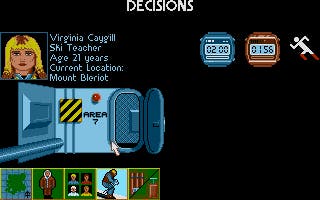Retrospective: Midwinter
Freeze a jolly good fellow.
Whenever I look out of the window to find that snow has covered the country like a carpet of white dung, my first thoughts are not of some bucolic childhood memory of sledges and snowmen. Nor does it bring to mind whimsical scenes from some classic Christmas movie, where snow is always brilliant white and accompanied by the sound of bells. No, for me, the sight of snow automatically takes me back to the hours I spent in 1989, hunched over my Amiga, carefully traversing a frozen island in Mike Singleton's brilliant Midwinter.
I don't really want to think about what that says about me, but what it says about Midwinter is abundantly clear. It's a truly seminal game, years ahead of its time in both ideas and technology, and one that has been rather criminally overlooked in recent years.
Midwinter was a product of one of those wonderful transition periods for the game industry, when the hardware moves forward and ingenious developers move in to see what's been made possible. If Midwinter were made today, marketing people would fall over themselves to smother it in sales-boosting bullet points, flagrantly throwing phrases like "cross genre" around and losing the meaning along the way.

Midwinter crossed genres, not because it seemed like a commercially shrewd way of covering lots of demographics, but because Singleton was literally discovering and reinventing genres as he went along. It's a pioneering piece of game design simply because nobody knew how to do this stuff.
Set in the future, following an Emmerich-scale global catastrophe that results in the planet being smothered in snow and ice, Midwinter takes place on a frostbitten island populated by a scattering of small dwellings and the ruthless armed forces of one General Masters. It's up to you, as John Stark of the Free Villages Police Force, to rally the inhabitants of the island into action against Masters, waging a guerrilla campaign to drive him out and secure your freedom by sabotaging factories, rescuing prisoners and crippling radio masts. It's the way you do this that makes Midwinter so memorable and so influential.
It's a first-person shooter. Oh, and a stealth game. It's also a free-roaming openworld adventure. And a social role-playing game, of sorts. None of these genres really existed back in 1989, or at least they didn't exist as the chart-topping behemoths we know today. Midwinter was, and still is, a unique creature; a priceless transitional specimen in the fossil record of gaming.

Exploration is the beating heart of the game, and you were able to wander the vast 160,000 square mile gameworld in numerous ways. Skis were the default mode of transport, a frankly terrifying experience that saw you scrunching up triangular peaks only to hurtle down the other side at 50mph. The Snow Wolf snowmobile was more secure, and the go-to option for rapidly covering the vast distances between locations, though its speed made it a risky choice on such uncertain terrain. Finally, and most daringly, you could use a hang glider to swoop down from the mountainous peaks.
All were capable of crashing horribly, which brings us to Midwinter's first memorable innovation. Injuries could cripple your limbs, which in turn would impact your abilities. Damaged legs made skiing a problem. Wounded arms made it harder to shoot straight. There were no medpacks in Midwinter, but time literally healed all wounds. Find a safe lodging and bed down, and even the most mangled limbs got better.
Unfortunately, time was a more precious resource than the spurious notion of "health". That's because, along with everything else, Midwinter was also a turn-based strategy game. The goal was to reach the other inhabitants of the island and recruit them to your cause. Once you had more characters on board you would synchronise watches and gameplay then revolved around controlling them in turn, in two hour chunks. So you'd control one character from 8am to 10am, then hop back in time to control the next character during the same timeframe. In this way, you manoeuvred and plotted the best way to beat Masters and his omnipresent army of snowmobiles and planes.








